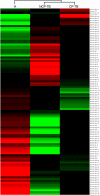Characterization of a novel panel of plasma microRNAs that discriminates between Mycobacterium tuberculosis infection and healthy individuals
- PMID: 28910318
- PMCID: PMC5598944
- DOI: 10.1371/journal.pone.0184113
Characterization of a novel panel of plasma microRNAs that discriminates between Mycobacterium tuberculosis infection and healthy individuals
Abstract
Cavities are important in clinical diagnosis of pulmonary tuberculosis (TB) infected by Mycobacterium tuberculosis. Although microRNAs (miRNAs) play a vital role in the regulation of inflammation, the relation between plasma miRNA and pulmonary tuberculosis with cavity remains unknown. In this study, plasma samples were derived from 89 cavitary pulmonary tuberculosis (CP-TB) patients, 89 non-cavitary pulmonary tuberculosis (NCP-TB) patients and 95 healthy controls. Groups were matched for age and gender. In the screening phase, Illumina high-throughput sequencing technology was employed to analyze miRNA profiles in plasma samples pooled from CP-TB patients, NCP-TB patients and healthy controls. During the training and verification phases, quantitative RT-PCR (qRT-PCR) was conducted to verify the differential expression of selected miRNAs among groups. Illumina high-throughput sequencing identified 29 differentially expressed plasma miRNAs in TB patients when compared to healthy controls. Furthermore, qRT-PCR analysis validated miR-769-5p, miR-320a and miR-22-3p as miRNAs that were differently present between TB patients and healthy controls. ROC curve analysis revealed that the potential of these 3 miRNAs to distinguish TB patients from healthy controls was high, with the area under the ROC curve (AUC) ranged from 0.692 to 0.970. Moreover, miR-320a levels were decreased in drug-resistant TB patients than pan-susceptible TB patients (AUC = 0.882). In conclusion, we identified miR-769-5p, miR-320a and miR-22-3p as potential blood-based biomarkers for TB. In addition, miR-320a may represent a biomarker for drug-resistant TB.
Conflict of interest statement
Figures





Similar articles
-
Levels of microRNA miR-16 and miR-155 are altered in serum of patients with tuberculosis and associate with responses to therapy.Tuberculosis (Edinb). 2017 Jan;102:24-30. doi: 10.1016/j.tube.2016.10.007. Epub 2016 Nov 1. Tuberculosis (Edinb). 2017. PMID: 28061948
-
Screening and identification of four serum miRNAs as novel potential biomarkers for cured pulmonary tuberculosis.Tuberculosis (Edinb). 2018 Jan;108:26-34. doi: 10.1016/j.tube.2017.08.010. Epub 2017 Aug 24. Tuberculosis (Edinb). 2018. PMID: 29523324
-
A Group of Novel Serum Diagnostic Biomarkers for Multidrug-Resistant Tuberculosis by iTRAQ-2D LC-MS/MS and Solexa Sequencing.Int J Biol Sci. 2016 Jan 1;12(2):246-56. doi: 10.7150/ijbs.13805. eCollection 2016. Int J Biol Sci. 2016. PMID: 26884721 Free PMC article.
-
A systematic review and meta-analysis of circulating serum and plasma microRNAs in TB diagnosis.BMC Infect Dis. 2024 Apr 15;24(1):402. doi: 10.1186/s12879-024-09232-0. BMC Infect Dis. 2024. PMID: 38622570 Free PMC article.
-
MicroRNAs as diagnostic biomarkers for Tuberculosis: A systematic review and meta- analysis.Front Immunol. 2022 Sep 27;13:954396. doi: 10.3389/fimmu.2022.954396. eCollection 2022. Front Immunol. 2022. PMID: 36238288 Free PMC article.
Cited by
-
MicroRNAs as immune regulators and biomarkers in tuberculosis.Front Immunol. 2022 Oct 27;13:1027472. doi: 10.3389/fimmu.2022.1027472. eCollection 2022. Front Immunol. 2022. PMID: 36389769 Free PMC article. Review.
-
A Panel of CircRNAs in the Serum Serves as Biomarkers for Mycobacterium tuberculosis Infection.Front Microbiol. 2020 Jun 9;11:1215. doi: 10.3389/fmicb.2020.01215. eCollection 2020. Front Microbiol. 2020. PMID: 32582119 Free PMC article.
-
Mechanisms of vascular comorbidity in autoimmune diseases.Curr Opin Rheumatol. 2018 Mar;30(2):197-206. doi: 10.1097/BOR.0000000000000483. Curr Opin Rheumatol. 2018. PMID: 29256898 Free PMC article. Review.
-
Tuberculosis diagnostics: overcoming ancient challenges with modern solutions.Emerg Top Life Sci. 2020 Dec 11;4(4):423-436. doi: 10.1042/ETLS20200335. Emerg Top Life Sci. 2020. PMID: 33258943 Free PMC article. Review.
-
Tuberculosis-Associated MicroRNAs: From Pathogenesis to Disease Biomarkers.Cells. 2020 Sep 24;9(10):2160. doi: 10.3390/cells9102160. Cells. 2020. PMID: 32987746 Free PMC article. Review.
References
-
- WHO. Global tuberculosis report World Organization Health; 2016. Available from: http://www.who.int/tb/publications/global_report/en/.
-
- Dorhoi A, Kaufmann SH. Pathology and immune reactivity: understanding multidimensionality in pulmonary tuberculosis. Seminars in immunopathology. 2016; 38 (2): 153–66. doi: 10.1007/s00281-015-0531-3 . - DOI - PubMed
-
- Barry S, Breen R, Lipman M, Johnson M, Janossy G. Impaired antigen-specific CD4(+) T lymphocyte responses in cavitary tuberculosis. Tuberculosis. 2009; 89 (1): 48–53. doi: 10.1016/j.tube.2008.07.002 . - DOI - PubMed
-
- Welsh KJ, Risin SA, Actor JK, Hunter RL. Immunopathology of postprimary tuberculosis: increased T-regulatory cells and DEC-205-positive foamy macrophages in cavitary lesions. Clinical & developmental immunology. 2011; 307631. doi: 10.1155/2011/307631 . - DOI - PMC - PubMed
-
- Ko JM, Park HJ, Kim CH, Song SW. The relation between CT findings and sputum microbiology studies in active pulmonary tuberculosis. European journal of radiology. 2015; 84 (11): 2339–44. doi: 10.1016/j.ejrad.2015.07.032 . - DOI - PubMed
Publication types
MeSH terms
Substances
LinkOut - more resources
Full Text Sources
Other Literature Sources
Miscellaneous

